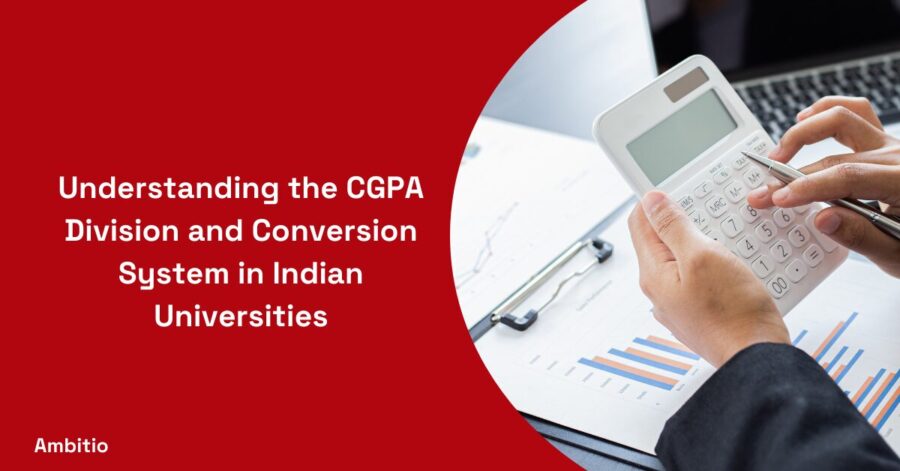13 December 2024
6 minutes read
Understanding the CGPA Division and Conversion System in Indian Universities

Introduction to CGPA Division in Indian Universities
The CGPA system in Indian universities is a comprehensive method of assessing a student’s academic performance across their courses. Unlike traditional percentage-based evaluations, CGPA offers a more nuanced view of a student’s capabilities and progress.
This system divides students into various divisions, such as 1st, 2nd, and 3rd, based on their cumulative performance, which is pivotal in gauging their academic standing.
The Role of CGPA in Grading and Academic Assessment
Understanding the CGPA Grading System
The CGPA grading system assigns a grade point for each course, factoring in the marks obtained by the student. These points are averaged, considering the credit hours of the courses, to arrive at the CGPA. This method provides a balanced view of a student’s academic abilities, taking into account the varying levels of course difficulty and student effort.
Division Classification in the CGPA System
Division classification categorizes students based on their CGPA. Generally, a CGPA of 6.0 or above is considered as 1st division in India. This classification is significant as it impacts opportunities for higher education and influences employment prospects. Students in higher divisions are often perceived as more academically accomplished, opening doors to prestigious universities and competitive job markets.
Converting CGPA to Percentage and Vice Versa
The Need for CGPA Conversion
Conversion of CGPA to a percentage is essential for students applying to international institutions or organizations that use different grading systems. Accurate conversion ensures that a student’s academic achievements are correctly interpreted and valued in diverse educational and professional contexts.
Using Online CGPA Calculators for Conversion
Online CGPA calculators are a boon for students needing to convert their grades. These calculators, equipped with algorithms that align with different university grading systems, provide a quick and reliable method for conversion, helping students present their academic records accurately and efficiently.
The Impact of CGPA Division on Academic and Professional Opportunities
How CGPA Division Influences University Admissions and Job Prospects
CGPA divisions significantly affect university admissions and job opportunities in India. Higher divisions, like the 1st division, often grant students access to prestigious postgraduate programs and coveted job roles, reflecting their academic prowess and potential.
The Global Perspective on CGPA and its Conversion
With the increasing interconnectivity in education, understanding CGPA in the context of international grading systems is crucial. This global perspective helps Indian students and professionals align their academic records with international standards, facilitating smoother transitions for higher studies or employment abroad.
Navigating the Challenges of CGPA Conversion
Common Pitfalls in CGPA Conversion
Converting CGPA to a percentage or other grading systems can be a complex process, and it’s essential to be aware of the common pitfalls that students often encounter. Understanding these can help avoid errors that may adversely affect academic and career opportunities.
- Misinterpreting the Conversion Formula: Each university may have a unique formula for converting CGPA to a percentage. A common mistake is using a generic formula found online, which might not align with the specific guidelines of your institution. Always refer to your university’s official conversion guidelines.
- Overlooking the Credit Weightage: Not all courses contribute equally to your CGPA. Ignoring the credit weightage of individual courses can lead to inaccurate calculations. It’s important to consider the credit hours assigned to each course when calculating your overall grade.
- Rounding Off Errors: Rounding off numbers prematurely during the conversion process can result in significant inaccuracies. Ensure that you follow the correct rounding-off rules as specified by your university or the conversion system you are using.
- Failure to Account for Failures or Repeats: If you have failed or repeated courses, these should be factored into your CGPA calculation accurately. Ignoring these can lead to an inflated or inaccurate representation of your academic performance.
- Neglecting Institution-Specific Grading Policies: Different institutions have their grading scales and policies. For instance, some might grade on a 10-point scale, while others use a 4-point scale. Applying the wrong scale can drastically alter your converted grades.
- Overlooking Variations in International Grading Systems: When applying to institutions or organizations abroad, it’s crucial to understand that grading systems can vary significantly. Converting your CGPA based on the Indian system directly to another country’s system without considering these variations can misrepresent your academic standing.
- Not Seeking Professional Help When Needed: Conversion of grades can be complex, and sometimes it’s best to seek help from academic advisors or professional services, especially for international applications. Doing it all by yourself, especially without proper understanding, can lead to errors.
- Ignoring Updates or Changes in Grading Policies: Educational institutions occasionally update their grading policies or conversion formulas. Not staying updated with these changes can result in using outdated methods for conversion.
- Confusing CGPA with GPA: While CGPA represents the cumulative grading point average across semesters or years, GPA often refers to the grading point average for a single term. Mixing these two can lead to incorrect calculations and interpretations.
- Assuming Uniformity Across Boards and Universities: The criteria for grade point calculation can differ between educational boards (like CBSE, and ICSE in India) and universities. Assuming a uniform grading system for all can lead to significant miscalculations.
By avoiding these common pitfalls, students can ensure a more accurate and representative conversion of their CGPA, which is crucial for further academic pursuits or professional endeavors, especially in environments where accurate academic assessments are critical.
Strategies for Accurate CGPA Conversion
Accurately converting your Cumulative Grade Point Average (CGPA) into a percentage or other grading format is crucial for applications to higher education or job positions, especially when dealing with international systems. Here are strategies to ensure precise conversion:
- Understand Your University’s Grading System: Familiarize yourself with the specific grading scale and policies of your university. Understanding the nuances of your institution’s CGPA system is the first step in accurate conversion.
- Use Official Conversion Tools: Many universities provide official tools or calculators for converting CGPA. Utilize these resources as they are tailored to the specific grading algorithm of your university.
- Check for Credit Weightage: Consider the weightage of each course when calculating your CGPA. Courses with higher credit hours have a greater impact on your overall CGPA, so they must be accurately factored into the conversion.
- Adhere to the Correct Formula: Each institution may have a different formula for converting CGPA to a percentage or other scales. Ensure you are using the correct formula as provided by your university or the relevant educational authority.
- Account for All-Academic Records: Include all courses, including those where you scored lower or had to retake. Excluding these can lead to a skewed representation of your academic performance.
- Stay Updated on Policy Changes: Grading policies and conversion formulas can change. Regularly check for any updates from your educational institution to ensure you’re using the most current information.
- Seek Clarification When in Doubt: If you’re unsure about any aspect of the conversion process, don’t hesitate to contact your university’s academic office or an educational counselor for clarity.
- Use Professional Conversion Services for International Applications: When applying to universities or jobs abroad, consider using professional grade conversion services. They are familiar with various international grading systems and can provide an accurate conversion.
- Double-Check Your Calculations: Errors can easily occur in manual calculations. Always double-check your work or have someone else review it to ensure accuracy.
- Understand International Grading Systems: If converting for international purposes, research the grading system of the target country or institution. Understanding their system will help you make a more accurate conversion.
- Document Your Methodology: When presenting your converted grades, it can be helpful to briefly explain the methodology or formula used, especially if applying internationally. This transparency can add credibility to your application.
- Avoid Unofficial Online Calculators: While they may be tempting, unofficial online calculators can often be inaccurate. Stick to university-provided tools or formulas.
- Prepare for Variations: Accept that different institutions or organizations might interpret your CGPA differently. Be prepared to provide additional explanations or documentation if required.
By following these strategies, you can ensure a more accurate and representative conversion of your CGPA, facilitating smoother academic and professional transitions, especially in environments where precise academic assessments are essential.
The Future of CGPA Division and Conversion in Indian Education
Evolving Trends in Grading Systems
As the Indian education system continues to evolve, so do the trends in grading systems. Understanding these changes, their implications for CGPA division and conversion, and the potential future shifts in grading methodologies is vital for students and educators alike.
Preparing for a Global Academic Environment
In an increasingly globalized academic world, Indian students must prepare to meet international educational standards. This preparation involves not only understanding CGPA conversion but also adapting to different academic cultures and expectations.
Conclusion
The CGPA division and conversion system in Indian universities is more than just a method of academic assessment; it is a framework that influences a student’s educational journey and career trajectory.
Understanding and effectively navigating this system is essential for students and professionals striving to excel in their endeavors, both in India and on the global stage.
FAQs
What is CGPA in the Indian grading system?
CGPA, or Cumulative Grade Point Average, is a grading system used in Indian universities to assess overall academic performance.
How is the CGPA calculated in Indian universities?
CGPA is calculated by averaging the grade points obtained in each course, considering the course’s credit hours.
What does 1st division mean in the CGPA system?
1st division in the CGPA system typically refers to a CGPA of 6.0 or above, indicating high academic achievement.
How can I convert my CGPA to a percentage?
To convert CGPA to a percentage, use an online calculator or the specific conversion formula provided by your university.
Is the CGPA system used internationally?
While the CGPA system is prevalent in India, different grading systems are used internationally. Thus, understanding and converting CGPA to the respective international system is necessary for global academic and professional pursuits.

You can study at top universities worldwide!
Get expert tips and tricks to get into top universities with a free expert session.
Book Your Free 30-Minute Session Now! Book a call now




























